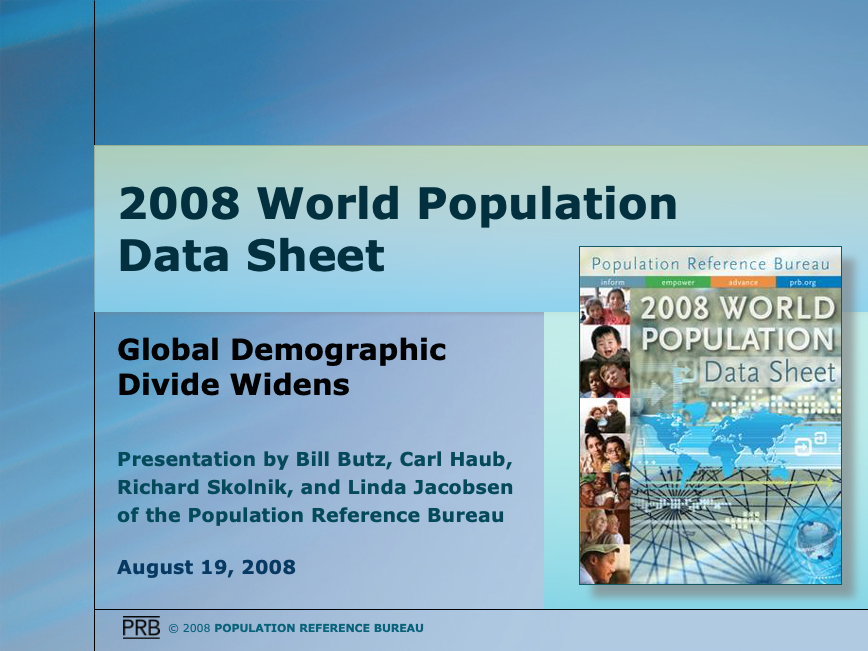
2008 World Population Data Sheet
Product: Webcast
Author: PRB
Date: August 26, 2008
- For Internet Explorer users: view webcast here. (Time: 55 minutes)
- For Firefox and Mac users: view webcast here.
- *Mac and Firefox users should also download the webcast’s corresponding presentation (PPT: 702KB).
(August 2008) The Population Reference Bureau released its 2008 World Population Data Sheet on Aug. 19, 2008, at the National Press Club in Washington, DC.
The theme of this year’s data sheet was “Global Demographic Divide Widens.” Each presenter illustrated his or her remarks with a series of Powerpoint graphics, which are synchronized with the presenter’s remarks:
Bill Butz, president and CEO of PRB, “Introduction”
Carl Haub, senior demographer: “World Population Trends” (time: 4:24 – 17:57)
Slides:
Developing Regions Make Up an Increasing Share of World Population.
More Developed Countries Have Fewer Young People Relative to Elderly.
Less Developed Countries Have More Young People Relative to Elderly.
Italy and the Democratic Republic of the Congo (formerly Zaire) Illustrate the Demographic Divide in 2008.
Every Country Has a Different Pattern of Fertility Decline.
What Do Global Population Projections Assume?
Just as Fertility Patterns Differ, So Do Those of Contraceptive Use.
Few Statistics Show Cross-Regional Gaps in Health Care as Does Maternal Mortality.
Richard Skolnik, vice president of International Programs, “Undernutrition” (time: 18:00 – 28:06)
Slides:
Many People Lack Required Calories.
Mother’s Education Is A Key to Children’s Nutritional Status.
Stunting Can Be Addressed.
The Countries With the Least Access to an Improved Water Source Have Among the World’s Fastest-Growing Populations.
Linda Jacobsen, vice president of Domestic Programs, “United States Population Trends” (time: 28:15 – 39:59
Slides:
The United States Has Been Growing Faster Than Expected.
Continued Population Growth Sets the United States Apart From Other Developed Countries Around the World.
By 2050, One in Every Five Americans Will Be Age 65 or Older.
The United States Will Continue to Become More Racially and Ethnically Diverse.
Ten Percent of U.S. Counties Have Already Reached Majority-Minority Status.
Minorities Make Up at Least 50 Percent of the Youth Population in One in Seven Counties Nationwide.
The Current Generation Gap in Racial-Ethnic Diversity Will Gradually Decrease by 2050.
Question and Answer (time: 39:59 – 55:00)

 ">
">
 ">
">